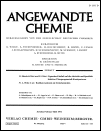Protonic States and the Mechanism of Acid-Catalysed Esterification
Abstract
Protons can be very mobile in condensed phases; the length of time they are present in any one place is minute. The significance of proton mobility in the course of chemical reactions is considered in the case of acid-catalysed esterification by the normal carbonyl addition mechanism. – The properties of the protons in the carboxylic acid/alcohol system can be discussed on the basis of a semiconductor term diagram. The high mobility of the catalysing protons in the semiconductor system suggests that formation of the esterification intermediates occurs in two reaction steps which proceed at different rates. In the first rapid step the transition state is reached by proton transfers via hydrogen bridges. The proton rearrangement involved proceeds so rapidly that the heavy molecular skeletons retain their mutual spatial positions (Franck-Condon principle for proton-catalysed reactions). In the second slower step, the intermediate is formed by rearrangement of the groups of atoms. – Decomposition of the intermediate, with formation of either the starting materials or the end products, proceeds via a mechanism similar to that for the formation.




